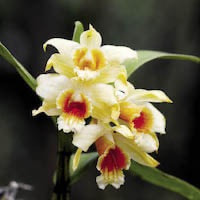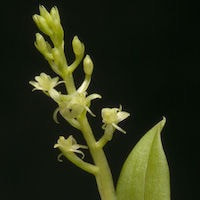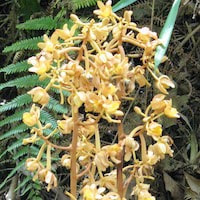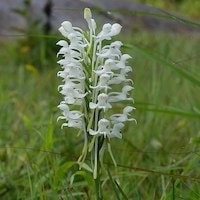MFL1 - Men's Floral 1, - Behind rose doors
|
Native Singaporean Orchid notes: Phalaenopsis Kilby Cassviola
Phalaenopsis Kilby Cassviola is a type of orchid featured in the fragrance Floral 1 (Men) used in Team building Perfume workshops. These orchids are commonly seen in hotels and office reception areas, native to Singapore and widely cultivated there. To meet demand, many are produced via tissue culture in countries like the Netherlands, Taiwan, and Thailand, ensuring a steady supply. Known for their sweet and spicy fragrance, they enhance sensory experiences wherever they're found.
|
Therapeutic Orchid notes:
|
Dendrobium cariniferum Rchb. f.
Dendrobium cariniferum, also known as Keel carrying Dendrobium, is an orchid species with scented white flowers. Found in Thailand as Ueang sae dong, Ueang ngoen daeng, Ueang kachok, Ueang tueng, and in Myanmar as Mahar deiwi, it adds aesthetic beauty wherever it grows. Apart from its ornamental use, it holds medicinal value as shihu in herbal practices, with specific applications varying across traditional medicine systems. |
|
Liparis stricklandiana Rchb. f.
Liparis stricklandiana, known as Shanchunyangersuan or Luhuayangersuan in Chinese, is an epiphytic orchid found in forests across regions like Hong Kong, China (Guangdong, Guangxi, Yunnan), Tibet, Vietnam, Sikkim, Bhutan, and Nepal. Apart from its natural habitat, this orchid is used in traditional medicine to treat sores, abscesses, and ulcers, believed to have healing properties for these skin conditions. |
|
Cyrtosia septentrionalis (Rchb. f.) Garay
Cyrtosia septentrionalis, also known as Galeola septentrionalis, is referred to as Xue hong rou guo lan in Chinese and Tsuchi-akebi or Dutuusoo in Japanese. This orchid grows in shaded forest understories, adapted with a self-pollinating system due to limited insect pollinators. It contains various glycosides and phenolic compounds. In traditional medicine, it treats muscle stiffness, skin ulcers with fungal infections, and historically, gonorrhea, also serving as a scalp tonic. |
|
Habenaria roxburghii, Nicolson Syn. Habenaria platyphylla Spreng
Habenaria roxburghii, also known as Habenaria platyphylla, is a type of orchid found in plains and scrub jungle areas, often near thorny bushes and on exposed rocks up to 800 meters in altitude. In Tamil Nadu, Ayurvedic practitioners use its tubers for medicinal purposes. They treat ailments like wasting diseases, fever, blood disorders, hemorrhage, and snakebites, especially among the Konda reddis tribal community in Andhra Pradesh. |
Other scent note
Rose oil, carnation, blue poppy, Alumroot, cyclamen, desert rose, dahlia, Gerbera, Gorse, Lotus, Mimosa and Marigold
Scentopia Library Reference ingredient
Frangipani - Sentosa's plants - Check details at Scentopia's scent library
Download the guided mediation that works best with this Orchid fragrance oil
| men_floral_essential_oil_orchi_00001.mp3 | |
| File Size: | 119043 kb |
| File Type: | mp3 |




